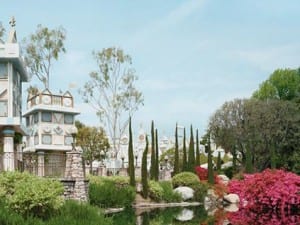Philippe Anthonioz is a French sculptor with a diverse portfolio of work that crosses many artistic boundaries. Often described as a “furniture sculptor,” Anthonioz’s work was on show in a dual exhibition at Galerie Tino Zervudachi in Paris and at Lefevre Fine Art in London 2007.
Anthonioz sculpts using plaster and bronze to create figures and furniture, and he makes no distinction between the two artistic genres. The decision to display furniture at Lefevre Fine Art is a departure for the gallery, which normally exhibits classic 20th century paintings, drawings and sculpture. Alex Corcoran, gallery manager, explains: “This is a furniture maker of such enormous talent that I felt he was credible enough to be shown in a fine art environment. Philippe’s work crosses the borders of design and fine art. The quality of the finish and his artistic approach to each piece is very impressive.”
Anthonioz’s sculptures are gracefully dignified, as well as unfailingly stylish. His light-fittings radiate elegance; his stairwells glide; and even his tables stand proud. His furniture is almost too beautiful and expressive to be used. However, Anthonioz is quick to point out that it would defeat the purpose of his work. “For example, tapestry is very decorative; no one could contest that it’s a piece of art, but it was useful in the beginning when houses were cold and tapestries gave warmth. Eventually, tapestries became decorative. Likewise, a table is something that you use; I want that my work is used.” The practicality of the pieces created is of fundamental importance. They may look exquisite, but that shouldn’t stop them from being functional.
Philippe Anthonioz’s approach begins like a blank canvas. He works with his materials and lets the shape naturally take form. Upon beginning a new piece, he is uncertain whether it will be a table, what diameter will be or if the legs will be round or square. “I don’t work as a designer. I find the shape when I’m working with the plaster. My medium is plaster, not bronze. When I begin, I don’t really know where I’m going to go.” This organic process is reflected in the pieces he produces. There is rawness in the work that remains after the original plaster moulds have been cast in bronze. He also works with other artists too: “My method is my method, but I continue to learn all the time. I’m very happy to collaborate with other people. For example, Guillime Saalburg (a specialist in glass), for the London exhibition, all the work was done collectively. We decided the shapes together; it was a duet.”
In the introduction to the catalogue for both the Paris and London exhibitions, Pierre Daix describes Anthonioz’s work as: “Not only decorative but shows the meaning of life. With him works of art are never aggressive but are first and foremost a visual conquest. His respect for wood, full of history, as well as for the richness of bronze, compose shapes which are capable of capturing the eye and of forging a special privacy and a contemplation which goes against the conformity of everyday life. Thanks to Philippe Anthonioz, the functional becomes poetry, the design of sculpture intervenes with the art of living.”
Such an affinity with his materials has grown from a lifelong relationship. “Ever since I was very young, I liked to work with my hands.” After a brief flirtation with architecture in the 1970s, Anthonoiz studied carpentry, however, he continues to return to plaster. “Plaster is my master material, from which I make moulds. For me plaster is a material that you can return to over and over again.”
This flexibility allows him to take the time required to produce commissions, which come from all over the world from architects such as Peter Marino, as well as, collectors and designers such as John Stefanidis.
Philippe Anthonioz’s work was on show at Lefevre Fine Art in London until 20 December 2007. www.philippe-anthonioz.com.
Rachel Hazelwood





